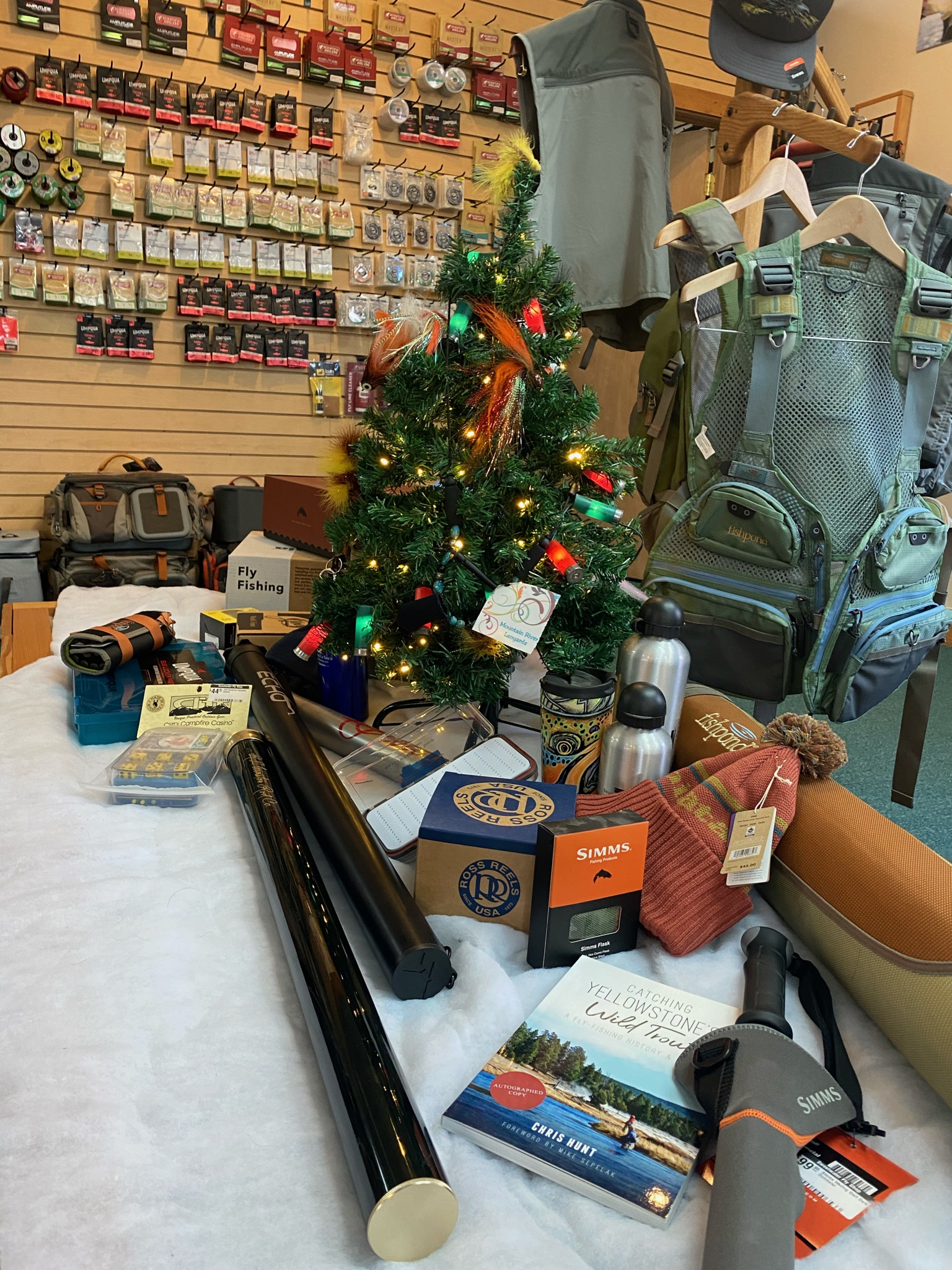
At Sweetwater Fly Shop, we believe that you can get the angler on your list something they’ll cherish without spending a fortune! On the other hand, if you want to really splurge, we’ve got that covered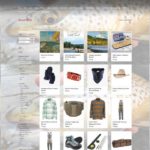 as well. This year, we’ve chosen a couple of dozen products that we would be proud to give to a friend or loved one, whatever your budget. Want to cut right to the chase? Check out the “Sweet Gift Ideas for All” link in our newly refreshed online store and shop away! I didn’t tell you this, but you can get 10% off your entire order of $100 or more by entering the discount code “GuineaPig10” at checkout! Place your order soon, so we can make sure to get it to you in time!
as well. This year, we’ve chosen a couple of dozen products that we would be proud to give to a friend or loved one, whatever your budget. Want to cut right to the chase? Check out the “Sweet Gift Ideas for All” link in our newly refreshed online store and shop away! I didn’t tell you this, but you can get 10% off your entire order of $100 or more by entering the discount code “GuineaPig10” at checkout! Place your order soon, so we can make sure to get it to you in time!
Today and tomorrow, I’ll give a little advice about the “Big 4” gifts for a fly angler – Rods, reels, waders, and wading boots. These bigger ticket items are pretty much must-haves for every angler, whether novice or long-timer. An upgrade in any (or an initial gift for a novice angler) would score you major points from the recipient! And all can be found at a wide range of prices, which brings up the question of what you’re getting by paying more. Let’s see if I can help!
Fly rods:
Let’s say you’re thinking of buying a very nice gift for a beginner or intermediate fly fisher, a new fly rod. Kudos to you! But it can seem a rather daunting task, particularly if you’re not an expert angler yourself. Maybe you’ve read some rod reviews. Confusing terms abound – line weight, rod action, graphite modulus, loop size…. And the price range, from (relatively) cheap to the sky’s-the-limit. What to do? Today, we’ll talk about some general considerations and tomorrow we’ll make some specific recommendations.
The first thing to consider is that in trout fishing, the rod does the majority of the work – casting, line management, playing the fish. The reel is to a certain extent a nice-looking line storage device. If you’re going to cut your costs anywhere, do so on the reel, not the rod. Yes, the $50 price tag on that Cabela’s rod is appealing, but you don’t want to set the recipient up for a thoroughly frustrating experience. You want to give a rod that is going to be enjoyable to cast, over and over. That the recipient will grow into, not quickly grow out of.
If the rod you’re purchasing is going to be the recipient’s primary or only rod for trout fishing, get a (9’0″) 5-weight rod. That’s the most versatile weight and length and will work well in virtually any situation, from smaller streams to big rivers. And get a 4-piece rod (most are, these days). They break down into a good length for carrying and travel and you don’t give up much, if anything, in terms of performance, relative to a rod with fewer pieces. There, that was easy!
What about rod action? To simplify a fair bit, action refers to the stiffness of the rod. A fast rod is the stiffest and bends the least during the cast. A slow rod, on the other hand, bends deeply during the cast. A faster rod tends to result in tighter casting loops (generally a good thing), longer casts, and better casts in the wind. On the other hand, a relative beginner will probably do better with a medium-fast rod. A little slower rod allows the caster to better feel the rod “load” (bend) during the cast, which helps the caster develop the timing which is so important in learning to cast well. Slow rods are a bit of a specialty item. In the hands of an experienced caster, they help the angler present the fly very gently, which is usually a good thing. If you’re buying a rod for someone who regularly fishes the Paradise Valley spring creeks, and who already has a faster rod, then a slower-action rod such as the Scott G-Series ($845) would be a big hit.
All that said, there’s still a pretty wide range of rods to consider. First off, for a beginner or intermediate angler, you don’t need to go with the very top end of the price range, unless you’ve got money to burn. A top-end fly rod is a bit like an expensive bottle of wine; it takes a true aficionado to appreciate its nuances. Just don’t settle for that bottle of plonk, either, to stretch the metaphor. That still leaves you with a couple of different price points to consider.What do you get for more money? To start, you’re more likely to get a rod made here in the U.S.. Most low- to mid-priced rods are produced overseas. Most mid-high to high-priced rods are produced in Montana (Winston), Colorado (Scott), or elsewhere here at home. If that’s important to you, you’re going to pay a little more. In addition, you’ll pay more for less weight. In general, the more you spend, the lighter the rod. The differences are in fractions of ounces, which doesn’t seem like much, but which adds up over hundreds of casts. Arm fatigue is a real concern. Finally, there’s the look of the rod. You pay for more expensive finishes – fancy wood reel seats, better grade cork in the handle, and other primarily aesthetic touches.
One thing that you won’t pay a lot extra for is an unconditional warranty against rod breakage. Rods break. They get stepped on, caught in car doors, break while casting or fighting fish, you name it. As long as you are willing to spend approximately $150 or more for the rod, and you’ll get a (relatively) free pass. The rod company doesn’t care how you broke your rod. Just send in the broken rod and pay a $50 to $150 “shipping and handling” fee, and they’ll repair it (or replace it, if necessary). We at fly shops have a love-hate relationship with the unconditional warranty, but for the consumer they’re a plus, and another reason to avoid bargain shopping. All of the rods that we’ll recommend come with such a warranty.
Let’s say you’re shopping for someone who has just become interested in fly fishing, but who doesn’t yet have a rod and reel (or who has become frustrated with “bargain basement” gear). A full fly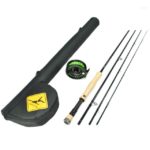 fishing “outfit,” complete with rod, reel, and fly line, would be a great start for such an angler. We never hesitate to recommend fly fishing outfits from Echo, which are one of the best values in the market. For someone who’s just getting their feet wet (sorry, it had to be said), the Echo Base Kit ($179.99) is a great option to get your angler going, and we wouldn’t recommend that you spend much less than that for an outfit that’s going to allow for smooth learning and not fall apart halfway through the first day on the water.
fishing “outfit,” complete with rod, reel, and fly line, would be a great start for such an angler. We never hesitate to recommend fly fishing outfits from Echo, which are one of the best values in the market. For someone who’s just getting their feet wet (sorry, it had to be said), the Echo Base Kit ($179.99) is a great option to get your angler going, and we wouldn’t recommend that you spend much less than that for an outfit that’s going to allow for smooth learning and not fall apart halfway through the first day on the water.
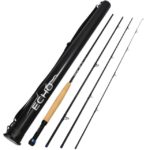 How ’bout the novice who’s ready to upgrade to a more mid-range fly rod as their skills develop, but not looking to move up to a top-of-the-line rod with the price tag to match? Echo makes a great value rod that “fights above its weight” when it comes to performance, the Echo Trout Fly Rod ($349)! The Echo Trout is light and responsive, has great feel, and will help just about anyone improve their casting without breaking the bank.
How ’bout the novice who’s ready to upgrade to a more mid-range fly rod as their skills develop, but not looking to move up to a top-of-the-line rod with the price tag to match? Echo makes a great value rod that “fights above its weight” when it comes to performance, the Echo Trout Fly Rod ($349)! The Echo Trout is light and responsive, has great feel, and will help just about anyone improve their casting without breaking the bank.
Or does your angler already have a full “quiver” of rods for different fishing situations? One style of fly fishing they might not have “covered” yet is Trout Spey casting. Originally developed for 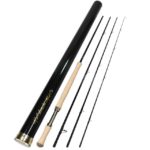 steelhead and salmon fishing, Spey casting is basically fancy roll-casting with a longer two-handed rod and allows the angler to make long casts, even when there’s not much backcast room due to bankside vegetation, etc… More and more trout anglers are discovering the advantages of lighter Spey rods for swinging streamers and wet flies on big western trout streams. Winston makes a sweet Trout Spey rod right here in Montana, the Boron III TH Microspey rod ($1099), which would be perfect for swinging flies on the Yellowstone River. The price tag is hefty, but any experienced angler who’s ready to do some long rod swinging would drool over this gorgeous and smooth-casting beauty!
steelhead and salmon fishing, Spey casting is basically fancy roll-casting with a longer two-handed rod and allows the angler to make long casts, even when there’s not much backcast room due to bankside vegetation, etc… More and more trout anglers are discovering the advantages of lighter Spey rods for swinging streamers and wet flies on big western trout streams. Winston makes a sweet Trout Spey rod right here in Montana, the Boron III TH Microspey rod ($1099), which would be perfect for swinging flies on the Yellowstone River. The price tag is hefty, but any experienced angler who’s ready to do some long rod swinging would drool over this gorgeous and smooth-casting beauty!
Buying a rod for a woman on your list? Yes, most women fish rods that were designed for “anyone,” but there’s something to be said for a fly rod designed and built by women, for women. Sara 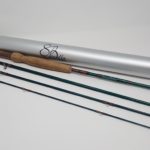 Bella rods are just that, and we have a couple of their sweet and colorful (no, not pink) rods in stock. Impress her with a 9′ 4-weight Sara Bella rod ($595) with a sweet dark green sparkle finish, which will cast even better than it looks!
Bella rods are just that, and we have a couple of their sweet and colorful (no, not pink) rods in stock. Impress her with a 9′ 4-weight Sara Bella rod ($595) with a sweet dark green sparkle finish, which will cast even better than it looks!
Check out all of our rods in our online store, and please get in touch if we can answer any questions!
Fly Reels:
Reels, like rods, come in several price points from inexpensive to, sometimes, pretty darn expensive. So, how do you know where to begin searching for a reel-y good Christmas present (That was bad, I know).
There are several ways to begin your search. First, determine how much you want to spend on your loved one (maybe your favorite loved one is yourself, then this will be easier).
Second, think of where that loved one likes to fish. Is it small water for small fish? Big rivers for larger fish? Saltwater? What kind of fish do they most often pursue: warmwater species, trout, salmon and steelhead? The answers to these questions will help you find the perfect reel.
If inexpensive is your primary factor then either you’re being a smart, frugal shopper or you may want to call the person for which you’re shopping a liked-one rather than a loved-one. Being honest is always the best choice.
Reels can be broken into two categories a couple of ways: type of drag system and method of construction. Their are two ways to construct a metal reel: pour a cast reel into a mold or cut one from a solid piece of metal (machined).
Cast reels are less expensive than machined reels because machining is more labor intensive. Machined reels are generally cleaner looking than cast ones. But the primary supposed advantage of a machined reel over a cast one is strength of materials. Machined reels are stronger. But 99% of the time that really doesn’t matter. And if you run either type of reel over with your car, you’ll be crushed and so will they. Finally, machined reels tend to be lighter than their cast counterparts.
If the person you’re shopping for is primarily a saltwater fisher then a cheap reel really isn’t an option. Salt water is corrosive, quickly destroying metal that isn’t designed to withstand it. So at the very least, you’ll want an anodized reel with a sealed drag system. These reels are almost always machined.
Anodizing creates a coating on the metal’s surface, through a chemical process, that protects the metal from scratches and dings, but also from salt water. Sealed drag systems prevent sand on other objects from entering the drag and destroying it.
Saltwater fishers and those who fish brawling rivers for salmon and steelhead also need reels with a greater capacity for holding backing and fly line. These big fish have more room to run in their larger watery abodes, and you don’t want your reel to run out of line.
Larger reels with great capacity generally cost more than smaller ones. You’ll also want to make sure the reel has a strong drag with a large surface area. Big fish in big water pull harder and longer than small fish in small water. That makes a reel’s drag system very important for these types of fly fishers.
Knowing all of this, you still don’t have to break the bank to buy a reel for a saltwater or steelhead and salmon fisher. But be aware that it will probably cost at least a couple hundred dollars for a decent reel in this category, though you can spend much, much more if you want to.
There are many more reel options for the trout and bass fisher. I know some fine anglers who insist that a trout reel is little more than a line holder and that drag systems are unimportant. And if you fish small water for small trout, that may be true. But even if you only hope of catching a large trout or bass someday, then your reel’s drag system should at least be considered.
There are two main categories of drag systems: click and pawl and disk drags. There are many types of “disk drags” but for our purposes here we’ll lump them all together.
Click and pawl drags are the simplest type. They are often (but not always) built into inexpensive reels. They basically work like putting a baseball card into the spokes on a bicycle. Only in a reel, the card is meant to cause friction against the spokes, causing the reel to turn slowly thereby tiring a fish. Click-and-pawl reels have experienced a bit of a resurgence lately, particularly in reels designed for small stream fishing. However, for most general purpose reel purchases, you’re going to want to invest in a reel with a disk drag.
Disk drags come in many forms. Just like building a better mouse trap, it seems as though each year another reel company hits the scene with yet another disk drag built a little differently or out of supposed better materials. But all of these reels usually have one thing in common: they cost more. Sealed disk drags generally require less maintenance (cleaning and lubrication).
Reel prices generally run from around $100 to $500 or more, depending upon brand, drag, and cosmetics. Yes, there are reels available from the “big box” stores that cost less than $100, but we don’t recommend them. After all, you don’t want to give your loved one a reel that’s going to go to pieces as soon as he or she hooks into a nice fish. Some reels from companies like Abel and others can be purchased with graphic images built into the finish and this adds to the price.
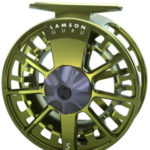 Let’s look at a couple of specific models from different reel companies and try to give you an idea of the best options to fit your needs and budget. Check out all of our in-stock reels in our online store and don’t hesitate to contact us with questions. Lamson has for years produced one of the best mid-range reel values with their fully-machined Guru series. The newest incarnation of the series, the Lamson Guru S ($260), sports some great updates to the already-great design and drag (and comes in sweet color finishes).
Let’s look at a couple of specific models from different reel companies and try to give you an idea of the best options to fit your needs and budget. Check out all of our in-stock reels in our online store and don’t hesitate to contact us with questions. Lamson has for years produced one of the best mid-range reel values with their fully-machined Guru series. The newest incarnation of the series, the Lamson Guru S ($260), sports some great updates to the already-great design and drag (and comes in sweet color finishes).
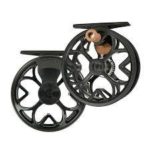 Any small creek fanatic will cherish a gift of the Ross Colorado LT ($295), a beautifully designed and built click-and-pawl drag reel perfect for those thin blue lines all over the map of Montana! It’s a super-light marvel of machining that will match perfectly with a light creek rod and make catching even the little guys a special occasion.
Any small creek fanatic will cherish a gift of the Ross Colorado LT ($295), a beautifully designed and built click-and-pawl drag reel perfect for those thin blue lines all over the map of Montana! It’s a super-light marvel of machining that will match perfectly with a light creek rod and make catching even the little guys a special occasion.
Want to give a novice or intermediate angler a high-quality value-priced reel with extra flexibility for different angling situations? Get them a Lamson Liquid 3-Pack ($170), which includes one of 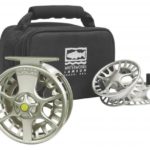 the best cast reels you can get, an extra spool so they can use the same reel with different weight lines/rods (or switch quickly between floating and sinking lines), all in a snazzy soft carrying case. It’s one of the best reel deals you can get, in my opinion!
the best cast reels you can get, an extra spool so they can use the same reel with different weight lines/rods (or switch quickly between floating and sinking lines), all in a snazzy soft carrying case. It’s one of the best reel deals you can get, in my opinion!
Next up in our gift list, waders and boots….!

Leave a Reply
You must be logged in to post a comment.